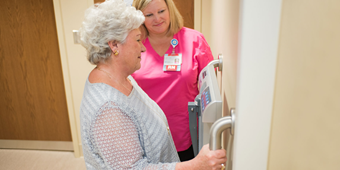HSG: An Inside Look into Fertility Issues

Answer a few questions and we'll provide you with a list of primary care providers that best fit your needs.
If you’re having difficulty getting pregnant and decide to undergo fertility testing, you’re likely to have a hysterosalpingogram. This is a noninvasive, outpatient diagnostic test that, when combined with other testing, helps infertility specialists (reproductive endocrinologists) gather a comprehensive picture of your fertility potential.
Hysterosalpingography (HSG) uses X-ray technology to view the inside of your uterus and fallopian tubes – the pathway an egg travels from your ovary to your uterus. The procedure, including preparation, usually takes about 30 minutes.
After HSG, you can immediately return to normal activities, though many doctors recommend refraining from intercourse for a few days.
What Can HSG Diagnose?
HSG can diagnose such fertility problems as:
- Blockage or narrowing of fallopian tubes
- Scarring of fallopian tubes and uterus
- Abnormalities in the shape and size of fallopian tubes and uterus
- Growths in the uterus (tumors or fibroids)
Infertility specialists can also use the test to investigate miscarriage causes. In some cases, additional testing may be needed to look more closely at your reproductive organs.
HSG can occasionally open blocked fallopian tubes, providing a slight increase in your chances of becoming pregnant for a short timeframe. However, most doctors use HSG for diagnostic purposes.
Before undergoing HSG, inform your physician or X-ray technologist if there is any possibility you may be pregnant. Radiation exposure from HSG is very low, but the test should not be done if you are pregnant.
Hysterosalpingography (HSG) uses X-ray technology to view the inside of your uterus and fallopian tubes – the pathway an egg travels from your ovary to your uterus.
How is HSG Performed?

You will lie on an exam table, much like for a gynecological exam. A contrast dye will be placed in your uterus and fallopian tubes. (Before the procedure, be sure to tell your doctor if you are allergic to iodine or intravenous contrast dyes.)
As the dye flows through, it highlights internal structures during X-ray imaging (fluoroscopy), helping pinpoint the location of problems.
HSG is not done if any of the following conditions are present:
- Pregnancy
- Pelvic infection
- Heavy uterine bleeding at the time of the procedure
If your fallopian tubes are blocked, your doctor may recommend a surgical procedure to directly view the tubes (laparoscopy).
Knowing what to expect before, during and after HSG will ease your mind and prepare you for the best self-care.
Does HSG Pose Risks or Cause Side Effects?
HSG usually causes mild or moderate uterine cramping for about five to 10 minutes. However, some women may experience cramping for several hours. You can reduce these symptoms by taking medications used for menstrual cramps before the procedure or as symptoms occur.
Severe problems after HSG are rare. However, there is a set of recognized complications, some serious, which occur less than 1 percent of the time, according to the American Society for Reproductive Medicine. These include:
- Pelvic infection. This is the most common serious complication, usually occurring in women with previous tubal disease. In rare cases, infection can damage the fallopian tubes.
- Fainting. Some women become light-headed during or shortly after the procedure.
- Spotting. Spotting sometimes occurs for a few days after HSG.
Call your health care provider if you have any of these symptoms after HSG:
- Foul-smelling vaginal discharge
- Vomiting
- Fainting
- Severe abdominal pain or cramping
- Heavy vaginal bleeding
- Fever or chills
Answer a few questions and we'll provide you with a list of primary care providers that best fit your needs.
Source: American Society for Reproductive Medicine; Radiological Society of North America; The American College of Obstetricians and Gynecologists




